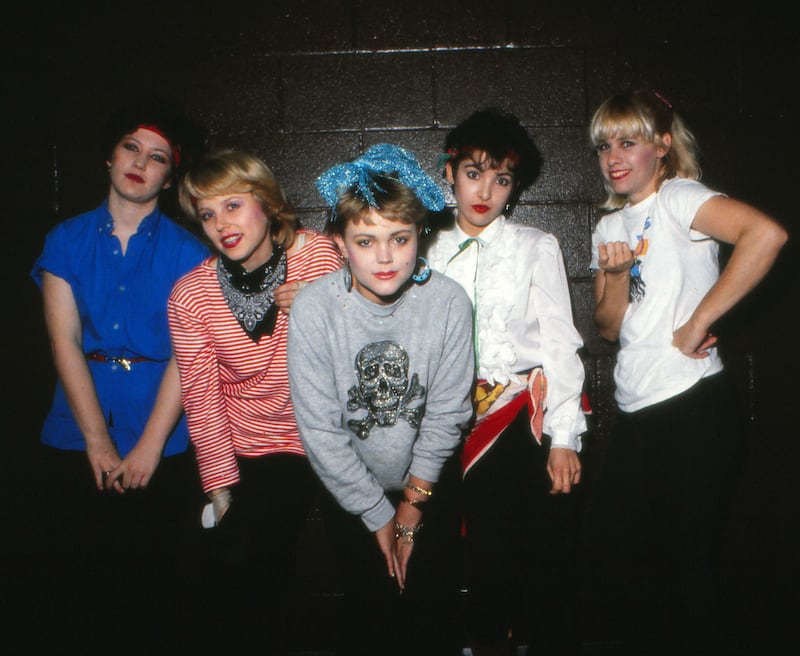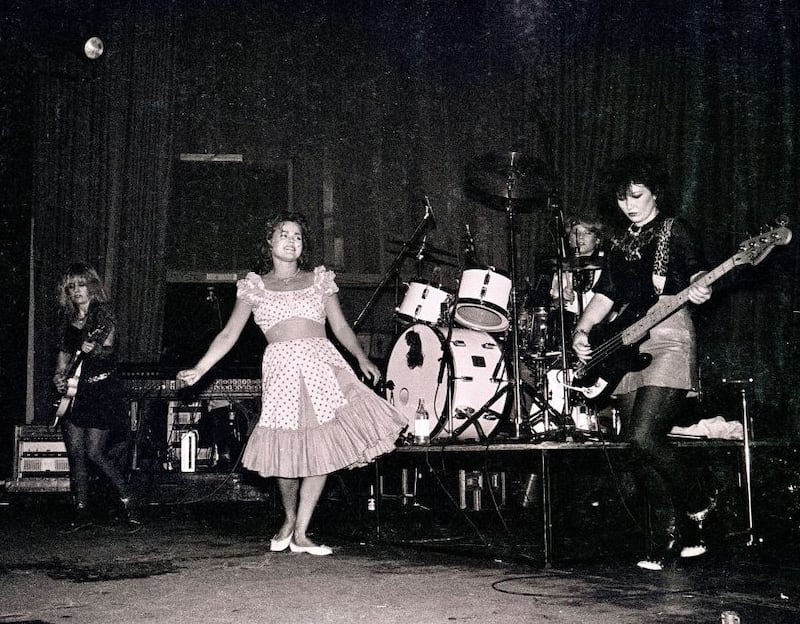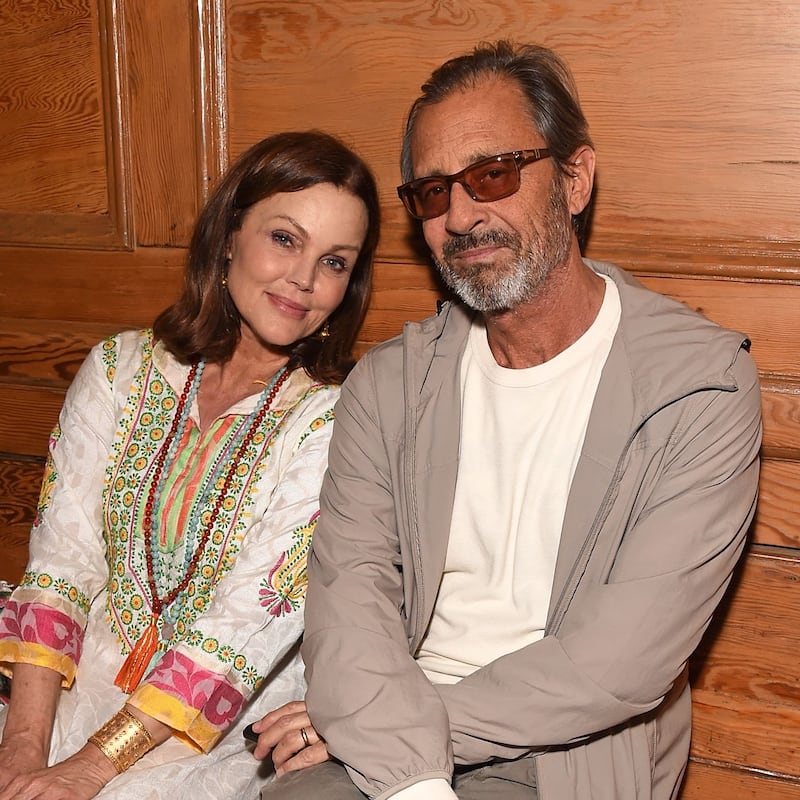It hardly matters – who really cares about these things? – and yet it does. This year The Go-Go's will be inducted into the Rock & Roll Hall of Fame, and earning a place at the museum in Cleveland, Ohio, for all its naffness, is still a mark of influence and recognition. "I always said, 'F**k them, I don't care,'" says Belinda Carlisle, the band's lead singer. "But when it actually happens, it's, 'Oh, this is not so bad.'"
The Go-Go's have had a reappraisal in the past year, thanks mainly to a documentary by the film-maker Alison Ellwood. It tells the story of how these scrappy young Los Angeles punks put together a band (the line-up shifted until arriving at the current five members) and made history – incredibly, they are still the only female band who write their own music and play their own instruments to have reached the top of the US album charts. That was in 1982. As with many women artists, belittled for years by the male-dominated music industry and press, the recognition feels long overdue.
The documentary also refocuses perceptions of Carlisle. After leaving The Go-Go's, she became a glossy pop star, but I love seeing the older images of her wearing a bin-bag dress, or facing down sexist thugs while on an early UK tour supporting Madness. On the phone from her home in Bangkok, Carlisle, who is now 64, is warm and unguarded. She laughs at the memory but also adds that it was "very intimidating. We would come off stage crying." But that tour, and the kudos they had earned on the US new-wave scene for touring Britain's ska clubs, was the turning point for the band. "It exploded after that," she says.
We're no prudes – we've seen everything and done everything. But it's an industry run by men. I don't see the empowerment in sexualising music that women perform
Until then, record companies refused to see the potential for The Go-Go’s, even if executives would go to their shows and see their adoring fans. “There had never been a female band that had been successful on a large level, so they couldn’t think out of the box,” says Carlisle. “There had been The Runaways, and Fanny, on a cult level, but not mainstream. We never thought in terms of gender – we didn’t want to be a good ‘female band’. We wanted to be a good rock’n’roll band. Thank God for Miles [Copeland, who signed them to his label]. He understood us.”
Why has no all-woman band matched their achievement in nearly 40 years? “I really have no idea,” says Carlisle. “I don’t think it has to do with sexism, because something like The Go-Go’s, with the right material, could be huge. But you need a record company that really loves music, and a lot don’t nurture their artists like they used to.”
The music landscape is so different now, with bands having lost ground to solo artists. In the DIY spirit of the 1970s, says Carlisle, “There were tons of clubs to play in and learn as you went along, and a scene that supported bands that were horrible, like us, in the beginning.” And for women artists, she points out, there is so much pressure to be polished and sexy in a way The Go-Go’s never were. They played at the Billboard awards in the US a few years ago, and sat watching the younger female artists perform. “We’re no prudes – we’ve seen everything and done everything. But it was so sexualised. It’s an industry run by men. I don’t see the empowerment in sexualising music that women perform.”

Growing up in Thousand Oaks, a city just outside Los Angeles, all Carlisle wanted to do was travel the world, and as a teenager she thought being a rock star would be a good way to do it. The oldest of (eventually) seven, in a volatile household, she wanted to escape. Her stepfather was an alcoholic whose idea of discipline was a beating – years later he sobered up, and, Carlisle says, "there were a lot of amends made". But as a child it left her with a drive to show him, and others, they were wrong. "I wanted to prove that I wasn't stupid, I wasn't a loser, I wasn't what they said I was." She was a nightmare teenager, she says: "Hitchhiking, running away, dropping acid. But at the same time I was a cheerleader, so I managed to be both people. I was born a little bit of a rebel, and that was one of the reasons punk music appealed to me."
Carlisle had been in two bands before The Go-Go's formed. They had no idea what they were doing – Charlotte Caffey, their guitarist, was asked to join "because she knew how to plug a guitar into an amp. That was what was great about the scene – you got a lot of support and even got guitar lessons from other bands. We just had a blast. It was a girls' club. No guys allowed, no boyfriends. We had girl roadies, female management." To go, as she puts it, "from zero to 100 in three years" felt like an explosion.
Their debut album, Beauty and the Beat, gave them two of their biggest hit singles, We Got the Beat and Our Lips Are Sealed. Drugs had been a problem for the band virtually from the start. In her 2010 memoir, Carlisle wrote that she was always “scared s**tless – scared that I wasn’t any good and the audience would see me as the fake I feared I might be”. So drugs and alcohol helped. “I don’t think I ever went on stage completely sober for years and years,” she says now.
I had a complete blast, but it does become a problem normally at some point. It was fun until it stopped being fun, and then it just became a real f**king nightmare. I mean, everybody was just off their trolley
Reading her book, it sounds as if she had impostor syndrome. “I felt like that for quite a long time,” she says. “When the Go-Go’s album went to No 1, I remember sitting in my kitchen, and I was on a bender, thinking, ‘I can’t believe it, I don’t deserve this.’ Maybe it’s because it happened so quickly. I think it also had to do with my issues from growing up and feeling uncomfortable in my skin.”
She says she knew she was in trouble with drugs “from the very beginning”. “I always had that little voice: ‘What are you doing?’” In the early days she was “an acid head. But when I was introduced to coke I thought, Oh my God, when I get money I’m going to buy lots of this. And I did.” She laughs. Three years after their album hit No 1, Carlisle had spent most of her money on drugs, clothes and, of all things, a racehorse.
Not to glamorise it, but it does sound wild. At a party for the band in New York, Liza Minnelli and Andy Warhol turned up. Rod Stewart threw a party for them in Rio; Carlisle spent much of the night driving around the city looking for cheap cocaine. As rock legend has it, Caffey partied so hard that even the notorious hellraiser Ozzy Osbourne once threw her out of his dressingroom. "Oh my God, I had a great time," says Carlisle. "I had a complete blast, but it does become a problem normally at some point. It was fun until it stopped being fun, and then it just became a real f**king nightmare." Drugs were one of the reasons the band broke up. "I mean, everybody was just off their trolley," she says.
I was told I would be more successful if I was a lot sexier, and sang songs like 'stick it in me'. That's literally what one person said. I was horrified. No man would ever have told The Go-Go's to do that
Another reason was money. As songwriters, Caffey, Wiedlin and the band's bassist, Kathy Valentine, earned more than Carlisle and the drummer, Gina Schock, which caused a lot of ill feeling. "I can see both sides," says Carlisle. She acknowledges that the song is vital, "but, at the same time, you can't really quantify what it is that makes The Go-Go's. All of us equally busted our asses." Although she admits that, at the time, "I was incapable of being creative. I couldn't really find it in me to ask for what I thought was fair, because I was such a mess."
Carlisle managed to stop taking cocaine around the time she launched a solo career. It sounds as if it was a bit of a shock to be out on her own. Under greater scrutiny than ever, she was told she would be more successful “if I was a lot sexier, and sang songs like ‘stick it in me’. That’s literally what one person said. I was horrified, because that had never happened before. No man would ever have told The Go-Go’s to do that.”
The media, too, became even more obsessed with Carlisle’s size; she had often been called the “plump” one of the band, but being marketed as a pop star came with added pressure, and she ended up developing an eating disorder. “It was horrible. I look back now, and I was normal – I would fluctuate in weight, and that was never an issue. I think one of the things that people loved about The Go-Go’s was we were normal girls. But when you’re that young, and weight was always mentioned when I was in the paper, that really messes with your head. That was one of the reasons I got into drugs, because I could keep my weight down.”

Although The Go-Go's always had a commercial flavour, Carlisle's solo career was pure 1980s pop. Did she not want to have more of a punk edge? "I grew up with California radio," she says. "I didn't really feel that it would be authentic to do a punk album, but I thought I'd go back to my really early roots of growing up with the radio on – I would lie in front of the speaker and sing along to all the hits. I just loved those really melodic, lush productions."
Her debut album was successful, but when her second album came out, in 1987, with its hit single Heaven Is a Place on Earth, it made Carlisle a huge star; then the pressures and temptations of touring got too much. By the time she was working on her fourth album, which flopped, Carlisle was back on cocaine, pausing only while she was pregnant with her son. She was dropped by her record company the day before she turned 40. “I was in a really bad place from age 40 to 47,” she says. She kept working, including occasional Go-Go’s reunions, but she says she can’t listen to her 1996 album, A Woman and a Man, “because it brings back really bad memories of where I was at. I could have phoned it in and done a better job.”
It's familial. It's not colleagues, it's sisters. I know that we all love each other, but the dynamics are really complicated. We may have taken others within the band for granted; we do not do that now. Forgiveness is important
Carlisle and her husband, the film producer Morgan Mason, lived in the south of France with their son, and Mason was reaching his limit; Carlisle had made attempts to get well but never stuck to it. "It was a horrible cycle. I was just sick of the lies and the drama, and I hated myself," she says. It came to a head in London in 2005, when she was recording an album of French songs; she didn't show up for rehearsals, instead going on a cocaine binge in her hotel room. She had the sudden realisation that she could die there, alone. "I just knew that it was only a matter of time before I died," she says.
Back home in France, she decided to stop everything. “I went out, got a big bottle of wine to celebrate my sobriety, and then, the next morning, I woke up and that was it. I was over cigarettes, over pills, over everything. I just stopped and got myself some help.” Carlisle joined Alcoholics Anonymous, and managed to finish her record. “That album got me through the early days of sobriety. I was able to be creative, and I didn’t really care if anybody ever heard it.”
Those years, although extremely difficult, were also “the beginning of the most interesting part of my life”, she says, “because I’d always been defined by what I did for a living”. The Dalai Lama’s book The Art of Living helped, and Carlisle read a lot about Buddhism; a few years earlier she had embraced the practice of chanting to help quiet her mind. “I was doing a lot of soul-searching. I wanted to connect to something bigger than myself.”

These days Carlisle seems pretty healthy – she is up at 4am to do yoga or Pilates. “I have a very active life,” she says. “I never really had that from the ages of 17 to 47.” Impressively, her marriage survived – she and Mason have been married for 35 years. They moved to Bangkok seven years ago, on the advice of friends. (Their son, James, now grown up, lives in the United States.) She loves the city’s energy. “I don’t know if we’ll be here for ever, because that’s not our nature, but in the meantime we really enjoy it. It’s a very exciting city.”
Carlisle is working on a new album, and she is touring Britain and Ireland this autumn. "I would never, ever have thought that I would still be working at this age, but I still love to do it," she says. The Go-Go's – newly, and finally, lauded – will probably play some dates, too, having forgiven and forgotten the feuds over the years. (At least one of them ended in a lawsuit.)
What has she learned about making relationships work? “I’m still trying to figure it out, 40-odd years later,” she says with a laugh. “It’s familial. It’s not colleagues, it’s sisters. I know that we all love each other, but the dynamics are really complicated. We may have taken others within the band for granted; we do not do that now. Forgiveness is important.”
Still, she says, "it's kind of tumultuous"; one of them is always in trouble with the others. "It's not me this week," she says, sounding relieved. But, contrarian and rebel that she is, there is also the barest touch of regret. – Guardian
Belinda Carlisle performs at Cork Opera House on November 1st and at Vicar Street, in Dublin, on November 2nd











